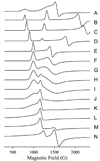Substrate binding preferences and pka determinations of a nitrile hydratase model complex: variable solvent coordination to [(bmmp-TASN)Fe]OTf
- PMID: 19166306
- PMCID: PMC2754792
- DOI: 10.1021/ic802180d
Substrate binding preferences and pka determinations of a nitrile hydratase model complex: variable solvent coordination to [(bmmp-TASN)Fe]OTf
Abstract
The five-coordinate iron-dithiolate complex (N,N'-4,7-bis-(2'-methyl-2'-mercatopropyl)-1-thia-4,7-diazacyclononane)iron(III), [LFe]+, has been isolated as the triflate salt from reaction of the previously reported LFeCl with thallium triflate. Spectroscopic characterization confirms an S = 1/2 ground state in non-coordinating solvents with room temperature microeff = 1.78 microB and electron paramagnetic resonance (EPR) derived g-values of g1 = 2.04, g2 = 2.02 and g3 = 2.01. [LFe]+ binds a variety of coordinating solvents resulting in six-coordinate complexes [LFe-solvent]+. In acetonitrile the low-spin [LFe-NCMe]+ (g1 = 2.27, g2 = 2.18, and g3 = 1.98) is in equilibrium with [LFe]+ with a binding constant of Keq = 4.7 at room temperature. Binding of H2O, DMF, methanol, DMSO, and pyridine to [LFe]+ yields high-spin six-coordinate complexes with EPR spectra that display significant strain in the rhombic zero-field splitting term E/D. Addition of 1 equiv of triflic acid to the previously reported diiron species (LFe)2O results in the formation of [(LFe)2OH]OTf, which has been characterized by X-ray crystallography. The aqueous chemistry of [LFe]+ reveals three distinct species as a function of pH: [LFe-OH2]+, [(LFe)2OH]OTf, and (LFe)2O. The pKa values for [LFe-OH2]+ and [(LFe)2OH]OTf are 5.4 +/- 0.1 and 6.52 +/- 0.05, respectively.
Figures










Similar articles
-
The first example of a nitrile hydratase model complex that reversibly binds nitriles.J Am Chem Soc. 2002 Sep 25;124(38):11417-28. doi: 10.1021/ja012555f. J Am Chem Soc. 2002. PMID: 12236756 Free PMC article.
-
A synthetic analogue of the active site of Fe-containing nitrile hydratase with carboxamido N and thiolato S as donors: synthesis, structure, and reactivities.J Am Chem Soc. 2001 Apr 11;123(14):3247-59. doi: 10.1021/ja001253v. J Am Chem Soc. 2001. PMID: 11457060
-
Synthesis and characterization of N2S3X-Fe models of iron-containing nitrile hydratase.Inorg Chem. 2003 Jul 14;42(14):4382-8. doi: 10.1021/ic026239t. Inorg Chem. 2003. PMID: 12844310
-
Fe(III) and Co(III) centers with carboxamido nitrogen and modified sulfur coordination: lessons learned from nitrile hydratase.Acc Chem Res. 2004 Apr;37(4):253-60. doi: 10.1021/ar0301532. Acc Chem Res. 2004. PMID: 15096062 Review.
-
A μ-Phosphido Diiron Dumbbell in Multiple Oxidation States.Angew Chem Int Ed Engl. 2019 Oct 1;58(40):14349-14356. doi: 10.1002/anie.201908213. Epub 2019 Aug 23. Angew Chem Int Ed Engl. 2019. PMID: 31350785 Free PMC article. Review.
Cited by
-
Identification of an Intermediate Species along the Nitrile Hydratase Reaction Pathway by EPR Spectroscopy.Biochemistry. 2021 Dec 14;60(49):3771-3782. doi: 10.1021/acs.biochem.1c00574. Epub 2021 Nov 29. Biochemistry. 2021. PMID: 34843221 Free PMC article.
-
Proton-Induced Switching of Paramagnetism: Reversible Conversion between a Low and High Spin CoIII Center within a Heterobimetallic Core.J Am Chem Soc. 2025 Jan 29;147(4):3129-3139. doi: 10.1021/jacs.4c12327. Epub 2025 Jan 15. J Am Chem Soc. 2025. PMID: 39813387 Free PMC article.
References
Publication types
MeSH terms
Substances
Grants and funding
LinkOut - more resources
Full Text Sources
Miscellaneous

